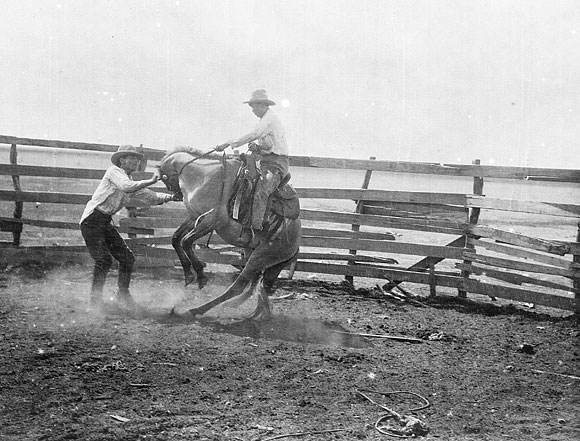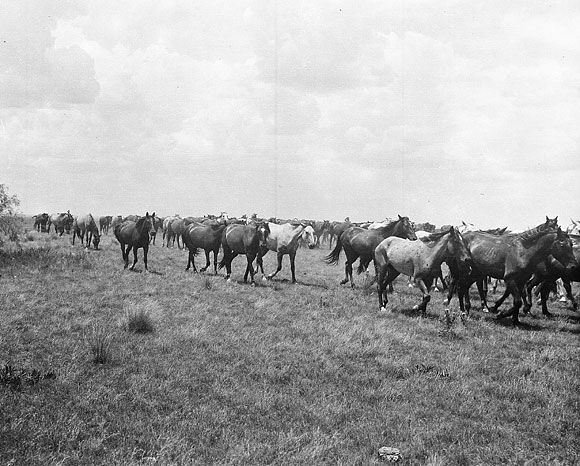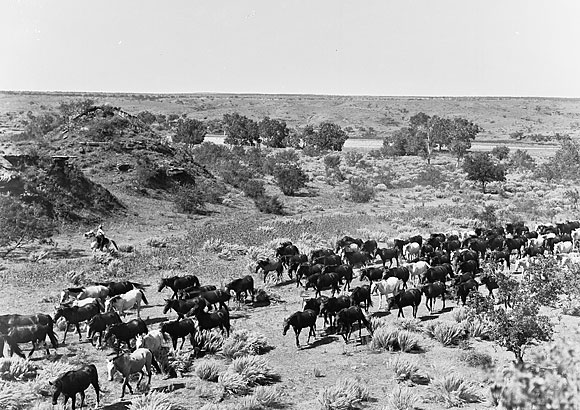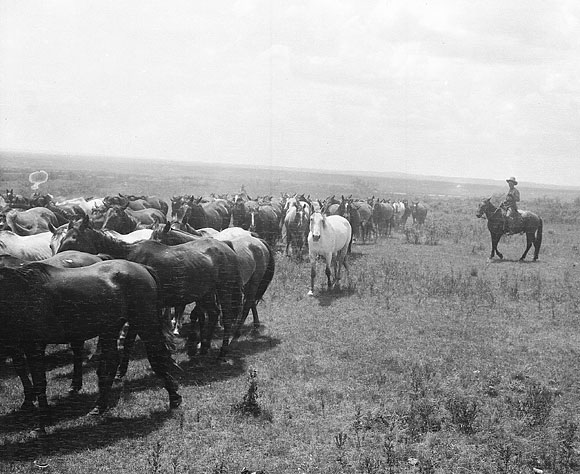Craig says the hardest horse is one that will not move. He used a flag to move Randal's horse around the round pen.
First Year
Click here for Second Year
For two years, Craig Cameron held horse clinics at the JA and cowboys have come from all five ranches. We decided to have the clinic to fine hone or improve everyone’s skills breaking and training horses, with the hope that, by using his techniques, we could have gentler horses and improve the safety of breaking horses. After two clinics, the last one a two day clinic, we feel that we have had great success.
| Getting the horse over fear is the first step. |
Craig says the hardest horse is one that will not move. He used a flag to move Randal's horse around the round pen. |
Craig taught us as much about teaching people as about teaching horses.
He is warm, friendly and laughs a lot.
The cowboys immediately bonded with him. When the first cowboy was rubbing his colt, Craig said,
“You can stand like that and it will probably be fine.
I like to stand in front of the shoulder in case he gets spooked—I can
get out of the way.” In
other words, he never said, “You are doing that wrong.”
He just told how he did it and why.
This was really brought home when Willie McCleskey from the Swamp was first putting weight on the stirrup. Willie is a great hand at breaking horses. Willie started patting the horse on his neck and rump and Craig said, “Pattings fine, but when they are nervous, rubbing is often less stressful.” Willie ignored him and kept patting the horse until the horse spooked. Later on, Willie said something about rubbing and not patting.
On other horses, Craig would pat the horse. Part of the lesson was to watch the horse and see where the horse is. Craig emphasized that every horse is different.
When Craig first saw the horses, he would notice how they stood, held their ears, their eyes and their lips. He would know within a few minutes how the horse needed to be handled. On one horse that never settled down, he put a rope around the front hoof and then over the saddle horn. He gradually applied pressure until the horse lifted the leg. He kept the pressure on, giving as the horse gave until the horse lay down. I never had the sense that the horse was hurting; but, there was not question that the horse did not naturally want to do what Craig wanted it to do. When the horse was lying down, Craig also was lying down on the ground. The horse was relaxed, at this time.
Craig talked of how the horses establish dominance with each other.
He said that they show no mercy until they realize they will not win and
then they accept. This horse
needed to accept Craig as dominant or it would run over him. Craig said you shouldn’t get mad if a horse
bites or kicks you. The horse
is just doing what he thinks he needs to do.
What the trainer needs to do is establish that the horse will not win,
doing this.
The heart of how Craig approaches horses is that they are horses.
One should not expect them to be otherwise.
They have eyes on the side of their heads so they can watch for predators
and they view man as a predator. He
says it is really incredible that they allow a man up on their back to ride
them. Craig looked at the
cowboys and said, “If you don’t understand why they see you as a predator,
think about what you have been picking out of your teeth.
There is no telling what you smell like to the horse.”
He said it is natural that they are scared of man.
What the trainer needs to do is get the horse over the fear and build
trust and confidence. He does
this by acting in a way that lets the horse learn that the man will not hurt
him. Watching him work with the horses, you could see that
the horses were more skittish on their right side than on their left.
All that had been done to the horses was that they had been haltered.
The halters are put on from the left side and cowboys do almost all work
on the horses on the left side.
Craig stressed the importance of messing with the right side of the
horse, as well.
Craig rubbed the horse with a rope a lot.
He would throw the rope over the horse and move it around.
He even would loop a rope around the flank and move it around.
The whole exercise was to teach the horse that neither the man nor the
rope would not hurt.
|
Billy familiarizes Senor Sunset to weight in the saddle without committing to riding. |
Even with all of the work to avoid it, John Anderson found that some horses are going to buck when first mounted. He kept his chin down and rode the horse.
|
There were a lot of differences in the horses. It took Billy about two hours to get his horse calm, saddled and mounted. Billy’s horse never bucked. Jason’s horse was ready to mount within about 45 minutes and also never bucked. John Anderson’s horse took two hours to be saddled and bucked for a long time with just the saddle on. He was not really bad once John mounted him, but he would not ride around the round pen. Randall's horse bucked both with the saddle and with Randall.
| Senor Mesquite showed
Rhett a lot of promise.
|
When training the horse to rein and turn,
Craig would apply pressure and, immediately, when the horse responded, Craig
would give slack. He said
that, if the trainer kept the pressure on, the horse would fight the pressure.
By letting the horse respond to the feel, the horse learned that proper
responses eased the pressure.
He spoke later of riding more experienced horses, saying that once you started a turn, you should ease up on the rein. To keep the horse turning, you could bump the horse with the opposite knee. In other words, you would use the rein to turn the horse’s head to the right. Then, you would ease up on the rein and bump the horses left shoulder with the rider’s left knee to keep it turning to the right.
At the end of the day all of the cowboys mounted their horses in the ring at the
same time. It was a proud moment for everyone and there was not a
rodeo. The cowboys ended the day by playing a game of catch with
anyone who missed catching the ball from their horse, out of the
ring. Both cowboys and horses relaxed.
| Willie's colt wanted to move. Billy looks a little tense. | At first, the cowboys were more nervous than their colts. |
Craig obviously enjoys his work.
What a different
world it is from that of the JA in 1908. When
JA 1908 horses
 |
 |
 |
 |
Return to Ranches.org or go to Sample JA Bloodlines, JA Remuda or Swamp Bloodlines.